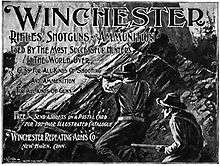.40-60 Winchester
The .40-60 Winchester is a centerfire rifle cartridge intended for 19th-century big-game hunting.[5] Nomenclature of the era indicated the .40-60 cartridge contained a 0.40-inch (10 mm) diameter bullet with 60 grains (3.9 g) of gunpowder. Winchester Repeating Arms Company necked down the .45-60 Winchester cartridge to hold a bullet with improved ballistics for the Winchester Model 1876 rifle.[2] The lever-action Model 1876's advantage of faster loading for subsequent shots was eclipsed two years later by the stronger and smoother Winchester Model 1886 action capable of handling longer cartridges with heavier bullets.[5] The .40-60 and similarly short cartridges designed for the Model 1876 rifle faded into obsolescence as 20th-century hunters preferred more powerful smokeless powder loadings of cartridges designed for stronger rifles. Winchester production of .40-60 cartridges ended during the great depression.[3]
| .40-60 Winchester | ||||||||
|---|---|---|---|---|---|---|---|---|
| Type | Rifle | |||||||
| Place of origin | United States | |||||||
| Production history | ||||||||
| Designed | 1884[1] | |||||||
| Manufacturer | Winchester Repeating Arms Company[2] | |||||||
| Produced | 1884-1934[3] | |||||||
| Specifications | ||||||||
| Parent case | .45-70[2] | |||||||
| Case type | Rimmed, tapered[3] | |||||||
| Bullet diameter | 0.405 inches (10.3 mm)[4] | |||||||
| Case length | 1.89 inches (48 mm)[2] | |||||||
| Ballistic performance | ||||||||
| ||||||||
| Test barrel length: 30 inches (760 mm) Source(s): Phil Sharpe[4] | ||||||||
References
- Durston, Kirk. "The Winchester Model 1876" (PDF). Retrieved 12 November 2014.
- Venturino, Mike. "Winchester Lever Guns & Their Black Powder Cartridges". Guns Magazine. Archived from the original on 2014-11-13. Retrieved 12 November 2014.
- Barnes, Frank C. (2012). Cartridges of the World. Gun Digest Books. p. 139. ISBN 1440230595.
- Sharpe, Philip B. (1953) Complete Guide to Handloading, New York, NY: Funk & Wagnalls pp.425&431
- Hacker, Rick (2014). "Winchester Model 1876". American Rifleman. National Rifle Association. 162 (November): 120.
